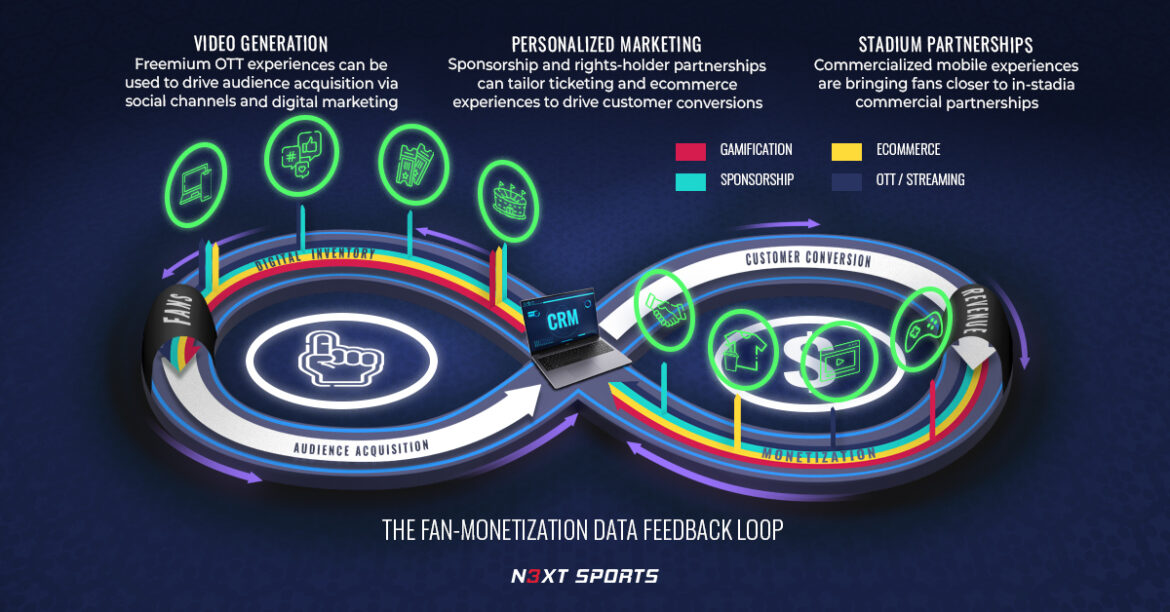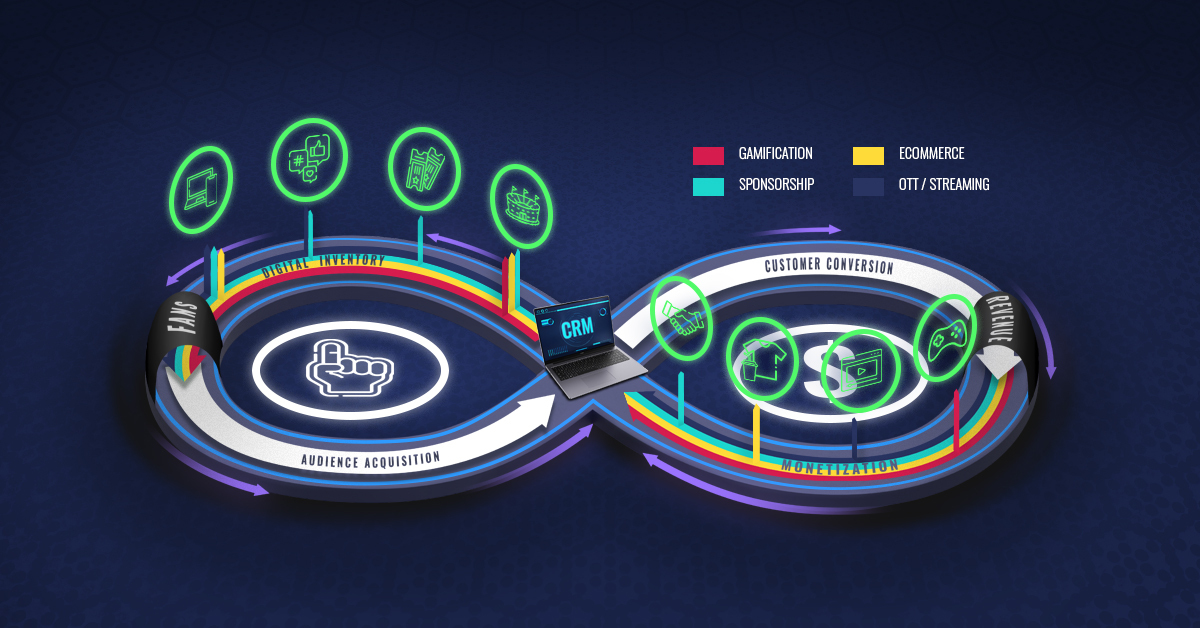Decision-makers inside sports properties have traditionally taken a linear approach to engaging with their organization’s fanbase. This invariably involves a fan-engagement strategy for driving audience acquisition at the earliest stages of the fan journey, also known as the fan funnel, before tailoring video content and segmented communications across the organization’s direct-to-consumer (D2C) portfolio to boost subscriber retention and customer conversions.
Albeit common practice for rights holders throughout the industry, this linear approach has become outdated in the modern age of data-informed fan engagement, with the evolution of mobile-centric, hyper-personalized user experiences (UX) taking precedence. Thus, as more clubs, leagues, and federations see value in consolidating their fan, athlete, and business data, omnichannel experiences are opening new revenue streams within a centralized user ecosystem and can no longer be measured fully within a one-directional model.
On the contrary, fan intelligence gathered at the business end of the fan journey (i.e. customer conversions) is being used to inform the different types of content strategies required to bring new fans into their digital ecosystem. In doing so, it is turning a once linear approach to fan engagement into an infinite cycle of fan data that not only informs sports properties on how to generate higher value per fan, but real-time intelligence and insights for driving engagement and retention at every stage of the fan journey.
In order to visualize this concept, N3XT Sports presents The Fan-Monetization Data Feedback Loop (see graphic below), which highlights how learnings from the monetization of the digital UX are used to inform other areas of a sports business. As the fan journey matures, so does the nature of the fan’s data, turning what was once static user information and basic behavioral trends into truly dynamic and transformative insights that provide the bedrock for new, highly engaging fan experiences.

For example, using data feedback, sports organizations are: (1) leveraging their freemium video content to drive audience acquisition, as well as customer conversions, via social media and digital marketing; (2) personalizing their sponsorship and rights-holder partnerships within the organization’s ticketing and commercial strategies; and (3) augmenting the stadium experience by bringing fans closer to in-stadia commercial partnerships via mobile.
As a result, understanding user behavior at a granular level uncovers unique strategies for driving fan loyalty and customer conversions. Therefore, to maximize fan value, it’s crucial that sports organizations and rights holders consolidate their data collection via a centralized information system which integrates every one of their data touchpoints, as well as an omnichannel fan experience which brings the fan journey and all that it entails into a single, user-friendly platform.
Mobile-centric experiences make it easier to centralize fan data
Data migration, a term often used for the consolidation of data silos, is a crucial step in a sports property’s digital transformation journey. Data migration is the task of transferring data to a location and structure that makes it accessible for other digital products and workflows. By centralizing their numerous information streams, sports properties present themselves with a 360° view of their organization’s dataflow, from managing the influx of large data sets, to the integration of optimization software and artificial intelligence (AI) to leverage meaningful behavioral insights from vast quantities of fan data.
Speaking on the benefits of data migration inside sports entities, Hisham Shehabi, N3XT Sports COO and regional head of MENA, says that data migration is “a continuous process, meaning that, even when a data migration to a new server or platform is completed, the cleaning and management of data does not stop there.” Adding: “Once all data sources have been integrated into the new setup, a sports organization is tasked with managing the conversion of data into intelligence.”
For sports properties operating at the earliest stages of their digital transformation, The Fan-Monetization Data Feedback Loop identifies how the centralization of data, via a customer relationship management (CRM) solution, for example, enables the organization to enhance its UX. As the industry continues to consolidate data to optimize its digital portfolio, several properties have gone a step further by integrating their entire D2C product-line within a mobile app. By utilizing an omnichannel experience in this way, organizations are making it easier to personalize the UX and, in turn, streamline the influx of large quantities of fan information and user feedback.
However, while mobile is revolutionizing both the in-stadia and at-home experience, and despite its benefits, many organizations have yet to incorporate a dedicated mobile product into their D2C ecosystem, according to N3XT Sports industry analysis, whereas the majority of properties have yet to transform their mobile product into a truly omnichannel experience. This is seen at every level of the sporting pyramid.
For example, research for N3XT Sports’ series of European football reports indicates that as few as 25 percent of the continent’s most digitally mature clubs offer a mobile-centric, omnichannel experience to their fans, highlighting opportunities even for some of the world’s most digitally diverse and commercially successful football clubs to optimize the fan journey and strengthen their dataflow.
A consolidated D2C offering allows for AI-enabled data governance
Digital transformation is providing the foundations for hyper-personalized fan and employee experiences – while AI is transforming how sport properties personalize the fan experience by optimizing data-driven decision-making. Albeit no organization’s digital portfolio is exactly the same, understanding the speed of digital-product adoption will be key for strategy planning inside sports organizations.
AI and machine learning tools are finding ways for sports organizations to leverage their data better, bringing new levels of efficiency to both the delivery of the digital UX and optimizing an organization’s internal communications. However, its success depends on the ability to process high-quality, well-governed data at scale. As AI redefines digital transformation in the sports industry, its integration must be guided by a clear business strategy, robust governance frameworks, and structured workforce enablement. Simply adopting AI is no guarantee of return on D2C investments.
Detailing AI’s role within the fan journey, N3XT Sports CIO Motasem El Bawab says: “Digital transformation is the foundation for subscriber growth and retention, while AI holds the potential to revolutionize audience engagement by surfacing untapped consumer insights. In 2025, CIOs and technology leaders must prioritize AI readiness, enterprise-wide data governance, and workforce upskilling – rather than chasing moonshot AI projects without clear business cases.”
Our team at N3XT Sports works tirelessly to develop and implement data and digital transformation strategies across a multitude of sports properties at federation level, competition level, and club level. To find out more about how N3XT Sports can serve your organization, fill out the form below, and we’ll be in touch. Our goal is to drive the digitalization of the sports industry and our clients.




